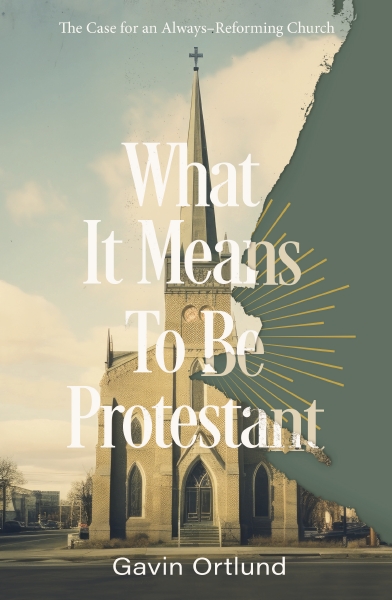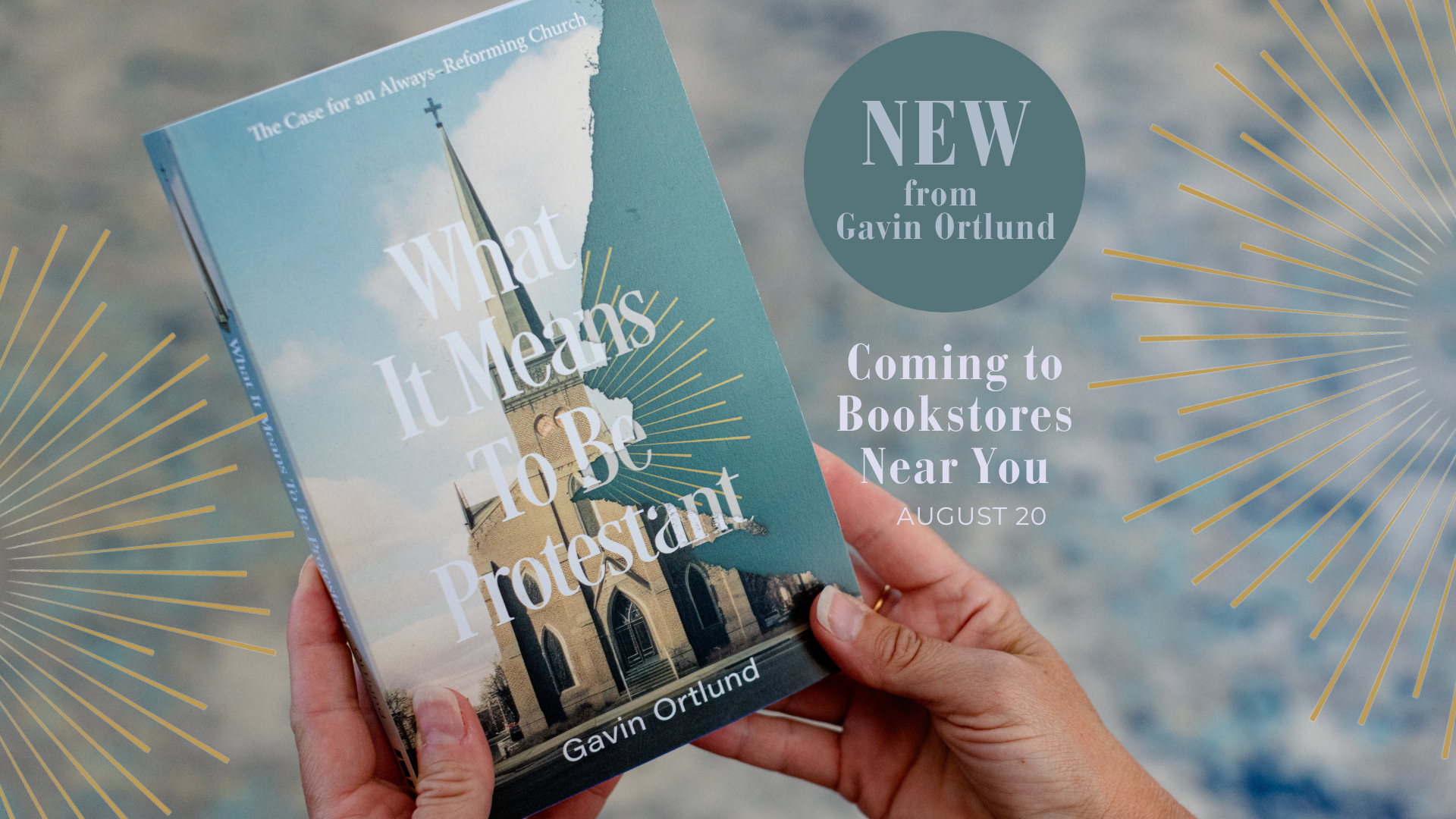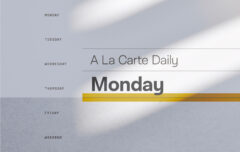This week the blog is sponsored by Zondervan Reflective. This post is written by Gavin Ortlund (PhD, Fuller Theological Seminary) who is president of Truth Unites and theologian-in-residence at Immanuel Nashville in Tennessee. He’s a highly sought-after speaker and apologist, and his new book What It Means to Be Protestant: The Case for an Always-Reforming Church releases on August 20, 2024.
In my engagements with Christians from traditions outside of Protestantism, whatever issue is being addressed, the discussion almost always kicks back to questions of authority. By what standard do we evaluate our differences? What is the relationship between Scripture and tradition, and where does the ultimate authority of interpretation for both Scripture and tradition lie? It is hard to find any area of dispute that doesn’t terminate in these more basic, methodological questions.
For this reason, we must press into the question of ecclesial authority. Here I will consider two of the most typical objections to sola Scriptura, the Protestant position on where ultimate authority over the church is located.
Objection 1: What about the Canon?
The church’s role in canonization is often set against sola Scriptura. Such critiques, however, generally fail to touch the Protestant position. Protestants stand in broad agreement with other traditions that the church has been entrusted with the responsibility of discerning the canon. For example, Protestants find themselves in a broad agreement on this point with the Roman Catholic position, as articulated at Vatican I: “these books the church holds to be sacred and canonical not because she subsequently approved them by her authority . . . but because, being written under the inspiration of the holy Spirit, they have God as their author, and were as such committed to the church.”1
The necessity of the church’s witness unto the Word of God is a classical Protestant doctrine. (The seventeenth-century Dutch Reformed theologians were particularly adept at explicating this doctrine). For Protestants, the church’s charge extends not only to recognizing the canon but also to protecting the Scriptures during times of persecution and to translating, teaching, and proclaiming them. Thus, Protestants have spoken of the church as not only a necessary witness to the Word of God, but also the custodian and herald of the Word of God.2
The necessity of the church, however, does not entail her infallibility. Protestants have often compared the church’s role in the process of canonization to that of John the Baptist in pointing to Christ: It is a ministerial role of witness or testimony. That the church is entrusted with such a task in no way grants her infallible authority parallel to Scripture any more than John the Baptist possessed parallel authority to Christ. Rather, the one testifying is subordinate to that which receives the testimony. As Johannes Wollebius put it, “As it is foolish to tell us that the candle receives its light from the candlestick that supports it, so it is ridiculous to ascribe the Scripture’s authority to the church.”3
Infallibility is not necessary for canonization since the church’s responsibility is not constituting Scripture but simply recognizing it. Such recognition is not itself the action of an infallible agent. As J. I. Packer more recently stated, “The Church no more gave us the New Testament canon than Sir Isaac Newton gave us the force of gravity. . . . Newton did not create gravity but recognized it.”4 Another metaphor for this action of the church used by the Anglican theologian William Whitaker is that of a goldsmith discerning true gold from other metals: “The goldsmith with his scales and touchstone can distinguish gold from copper and other metals; wherein he does not make gold . . . but only indicates what is gold. . . . In like manner the Church acknowledges the Scriptures and declares them to be divine.”5
For there is no higher authority the Word of God could rest upon than the Spirit speaking through it.
Gavin Ortlund
Ultimately, the trustworthiness of the canon is rooted in the guidance of the Holy Spirit, as well as the progressive nature of revelation itself. Thus, the Italian Reformer Peter Martyr Vermigli pointed out that in the work of discerning the Word of God, the church does not start from scratch, but measures each book against the previous revelation she has already received from God. As Richard Muller expounds Vermigli’s view, the church “adjudges the canon only as she is taught so to do by the Spirit of Christ, her Teacher, and by the comparison of Scripture with Scripture— even as a counterfeit letter is proved by comparison with a genuine letter.”6 Muller points out that in explaining the church’s role in this way, Vermigli and other early Protestants like William Tyndale were not innovating—they were simply repeating a view that had strong attestation in medieval scholastic debate, most recently by the fifteenth-century theologian Wessel Gansfort.7 The idea of a hierarchy of authorities, with the Scripture at the top over other subordinate (but necessary) authorities, was by no means a novel approach in the sixteenth century.
To state the point plainly, setting sola Scriptura at odds with the process of canonization confuses the recognition of infallibility with the possession of infallibility. The simple fact is that it is not necessary to be infallible to discern that which is infallible. When Moses heard God at the burning bush, he didn’t need a second voice whispering in his ear that this was indeed God. This is what Protestants intend when they speak of Scripture as self-authenticating. This simply means that the ultimate ground on which we receive the Scripture is inherent in it, rather than external to it. For there is no higher authority the Word of God could rest upon than the Spirit speaking through it. If you think you do have to possess infallibility to discern infallibility, you have a continual regress, because now you need infallibility to receive and interpret the infallible teachings of your church.
There is one way we can know with certainty that the church does not need infallibility to discern the canon: the facts of history. It just didn’t happen that way. With respect to the New Testament canon, scholars debate the exact date of its finalization, but it is generally seen to have become fully settled in the fourth century. The process of canonization leading to that point was bottom up, not top down. It was a gradual, cumulative, widespread, and organic process by which the church discerned the Word of God through the enabling direction of the Holy Spirit. It was not the result of an infallible statement from the Pope of Rome or an ecumenical council. As Collins and Walls note, “The canon emerged independently about the same time in the East, the West, and northern Africa.”8 In this process, Athanasius’s Thirty-Ninth Festal Letter in 367 was particularly significant, confirmed at the Synod of Hippo in 393 and the Council of Carthage in 397. It is disputed whether the same canon list was adopted at the Council of Rome in 382, but either way, this council was not regarded as settling the issue.9 It was not an ecumenical council. It was not infallible.
The fourth-century New Testament canon was the result of a process that began within the New Testament itself, where various books are identified as Scripture (2 Pet. 3:16; 1 Tim. 5:18). Furthermore, as Michael Kruger points out, the New Testament authors frequently betray an awareness that they are writing with divine authority.10 Hence throughout the second and third centuries, books like Matthew, Acts, and Romans were not in dispute and were quoted with the same authority as the Old Testament Scriptures.11 The only dispute was around the fuzzy edges (for example, Revelation, 2 Peter, The Shepherd of Hermas). This does not render the final determination unimportant. It simply reinforces the central point here: Christians do not need an infallible act of the church to discern Scripture.
Similarly, the Old Testament canon was also not the result of an exercise of infallibility among the people of God. The Jewish people did not have an infallible teaching office, yet throughout their history, they were able to recognize and receive the Word of God given to them in what we call the Old Testament Scriptures. This is not to say, of course, that there were no disagreements about certain books (for example, Ecclesiastes and Esther) or alternative canons among various outlier groups (for example, the Samaritans, who were not considered Jews, held only to the Torah). Scholars debate when the canon of the Jewish people was closed, but it seems there was a “core” Old Testament canon in the mainstream Jewish tradition by the time of Jesus, sometimes referred to as the Law, the Prophets, and the Writings (or simply as the Law and the Prophets).12 For example, the first-century Jewish historian Josephus referred to a Hebrew Bible of twenty-two books (corresponding to the thirty-nine books of the Protestant Old Testament), and appeared to conceive of the canon as closed.13
But what is significant for our purposes is simply to note that Jesus held the Jews of his day to the authority of Scripture despite the fact that there was not an infallible declaration of the canon among the Jewish people (Luke 16:16; 24:44; John 5:47, and more). This entails the possibility of receiving infallible revelation of God and recognizing it as such without an infallible decree from the church.
This argument from the canon against sola Scriptura is commonly made, but it falls apart under scrutiny. Even the Roman Catholic Church had a “fallible canon” for most of her history, since the canon was not infallibly defined until the Councils of Florence and Trent toward the end of the Middle Ages. Moreover, today the Roman Catholic Church also has a “fallible list of infallible teachings,” since the number of ex cathedra statements and other infallible forms of teaching has never been infallibly defined and is disputed. Similarly, other churches have a “fallible list of infallible councils.” This is not a problem for them; neither is canonization for sola Scriptura.
Objection 2: Doesn’t the New Testament Teach Us to Obey “Traditions”?
Criticism of sola Scriptura often points to the positive role of tradition in the New Testament:
- “Now I commend you because you remember me in everything and maintain the traditions even as I delivered them to you” (1 Cor. 11:2).
- “So then, brothers, stand firm and hold to the traditions that you were taught by us, either by our spoken word or by our letter” (2 Thess. 2:15).
But these passages have nothing to do with sola Scriptura. Of course particular local churches would receive and obey apostolic traditions in the first century (as well as apostolic teaching in other forms). That would be true for every first-century apostolic church. This happened during the apostolic era, while Scripture was still being written. These traditions do not exist as an infallible rule for the church today— as I have noted, the transmission of oral teachings is fallible and led to immediate disputes in the early church.

Unfortunately, criticism of sola Scriptura sometimes completely overlooks the distinction between the apostolic age and the post-apostolic age. For example, Josiah Trenham, quoting 2 Thessalonians 2:15, asks, “Are we to suppose, as the sola Scriptura theory would have it, that you were only to obey the Apostolic teachings and injunctions that St. Paul wrote down and not those that you heard from his own mouth?”14 But the notion that sola Scriptura would give license to first-century Christians to disobey the apostles’ oral instruction is an extreme caricature. For starters, sola Scriptura in no way designates Scripture as the only authority to be obeyed (as opposed to only infallible rule). More basically, sola Scriptura is a framework for the church as such, not for Christians in the apostolic age sitting under the teaching of living apostles, during the era in which Scripture was still being written. When passages like 2 Thessalonians 2:15 are set at odds with sola Scriptura, this simply reflects that the doctrine has been misunderstood.
Setting sola Scriptura at odds with tradition typically involves an equivocation on the word tradition. Martin Chemnitz listed eight different definitions of the word tradition as it was used by the church fathers, the first seven of which are completely harmonious with sola Scriptura.15 It is only the eighth kind of tradition, that which was affirmed at the Council of Trent, that sola Scriptura opposes. This kind of tradition Chemnitz defines as “traditions which pertain both to faith and morals and which cannot be proved with any testimony of Scripture but which the Synod of Trent nevertheless commands to be received and venerated with the same reverence and devotion as the Scripture itself.”16
More simply, Heiko Oberman distinguished between two broad conceptions of tradition that developed throughout church history. “Tradition 1” sees tradition as indispensable but primarily in the role of supplementing Scripture, not as a separate source of divine revelation. In this view, Scripture must be interpreted in the context of the church and the rule of faith, but it is the sole source of divine revelation. “Tradition 2” sees tradition as a separate source of divine revelation, especially rooted in Christ’s forty days of teaching his disciples between his resurrection and his ascension (Acts 1:3), not written down but allegedly preserved by the magisterium of the church.17
It took considerable time in church history for this second conception of tradition to emerge and then later become accepted. Historians disagree on when precisely the transition from “Tradition 1” to “Tradition 2” happened, but it is a controversial debate throughout the medieval era.18 When early Christians like Irenaeus appealed to tradition, they were frequently referring to what was coincident with the content of Scripture, not a separate rule or source of revelation. It was not until the fourth century (in Basil’s writings, for example) that there emerged a clear conception of unwritten tradition as a separate norm from Holy Scripture. But even there, the traditions more commonly referred to are liturgical practices, not universal obligatory dogmas that lack scriptural warrant. As J. N. D. Kelly notes,
All the instances of unwritten tradition lacking Scriptural support which the early theologians mention will be found, on examination, to refer to matters of observance and practice (e.g. triple immersion in baptism; turning East for prayer) rather than doctrine as such, although sometimes they are matters (e.g. infant baptism; prayers for the dead) in which doctrine is involved.19
Furthermore, even Basil shows concern for the necessity and priority of Scripture. For example, when arguing for the legitimacy of the phrase “with him” in the doxology, Basil appeals to tradition but then immediately adds, “but we are not content simply because this is the tradition of the Fathers. What is important is that the Fathers followed the meaning of Scripture.”20
Despite the numerous different meanings of the word tradition, critics of sola Scriptura sometimes employ any positive instance of this term as though it were speaking of tradition in the sense defined at the council of Trent. But it is specifically that conception of tradition that sola Scriptura opposes— namely, that Scripture and tradition are to be received with equal reverence as they together constitute the deposit of the Word of God, and that the magisterium of the church can offer infallible interpretations of both.
Protestants reject this schema because tradition is not the inspired Word of God, and when it is made equal to Scripture and the magisterium is put in the role of interpretation, then it is really the magisterium that has ultimate authority. In this way, the church is ultimately untethered from accountability to the inspired Word of God, resulting in, as Keith Mathison puts it, “a Church which is a law unto itself.”21 Protestants have referred to this position with phrases like sola ecclesia and solum magisterium to reflect the concern that the practical effect of this position (if not the intention) is to place the church above Scripture (and tradition).22
Hence the scandal of obligatory dogmas that have no testimony in Scripture or early tradition (like the issues we will peruse next in this book, the bodily assumption of Mary and the veneration of icons). These are good examples of what is at stake with a Protestant conception of authority in the church. In sum, sola Scriptura is not a generic rejection of tradition; it’s a rejection of those kinds of tradition.
Notes
- E.g., Decrees of the First Vatican Council, Session 3, Chapter 2, https://www.papalencyclicals.net/councils/ecum20.htm, accessed May 31, 2023.
- For helpful examples, see Richard A. Muller, Post-Reformation Reformed Dogmatics, vol. 2: Holy Scripture: The Cognitive Foundation of Theology (Grand Rapids: Baker, 1993), 358–88.
- As cited in Horton, The Christian Faith, 193.
- As cited in Kenneth J. Collins and Jerry L. Walls, Roman but Not Catholic: What Remains at Stake 500 Years After the Reformation (Grand Rapids: Baker Academic, 2017), 21.
- As cited in Philip Edgcumbe Hughes, Theology of the English Reformers (Grand Rapids: Eerdmans, 1965), 36.
- Muller, Post-Reformation Reformed Dogmatics, Vol. 2, 361.
- Muller, Post-Reformation Reformed Dogmatics, Vol. 2, 358–63.
McGrath, The Intellectual Origins of the European Reformation (Grand Rapids: Baker, 1995), 140–51, also draws attention to points of continuity between the Protestant position on this point and a tradition of thought throughout the fourteenth and fifteenth centuries.
- Collins and Walls, Roman but Not Catholic, 21.
- For an overview of the canonization of the New Testament, see John D. Meade and Peter J. Gurry, Scribes and Scriptures: The Amazing Story of How We Got the Bible (Wheaton, IL: Crossway, 2022), 147–65.
- Michael J. Kruger, The Question of Canon: Challenging the Status Quo in the New Testament Debate (Downers Grove, IL: IVP Academic, 2013), 119–54.
- On this point, see Peter Balla, “Evidence for an Early Christian
Canon (Second and Third Century),” in The Canon Debate, eds.
Lee Martin McDonald and James A. Sanders (Peabody, MA: Hendrickson, 2002), 372–85.
E.g., see Kevin J. Vanhoozer, endorsement of Collins and Wallins, Roman but Not Catholic; for an explication of this concern, Horton, The Christian Faith, 187–98.
For helpful discussion, see Meade and Gurry, Scribes and Scriptures, 111–20.
For discussion, see Steve Mason, “Josephus and His Twenty-Two Canon,” in The Canon Debate, 110–27. The question of which Old Testament canon is the correct one is out of the scope of this chapter (I have addressed that elsewhere); our concern is to show that the recognition of Old Testament Scripture as such did not depend on an exercise of infallibility by the people of God. For a classic defense of the Protestant Old Testament canon, see William Whitaker, trans. William Fitzgerald, A Disputation on Holy Scripture Against the Papists, Especially Bellarmine and Stapleton (Cambridge: Cambridge University Press, 1849), 25–109.
For example, Josiah Trenham, Rock and Sand: An Orthodox Appraisal of the Protestant Reformers and Their Teachings, 3rd ed. (Columbia, MO: Newrome, 2018), 163.
Chemnitz, Examination of the Council of Trent, vol. 1, 219–307.
Chemnitz, Examination of the Council of Trent, vol. 1, 272.
Heiko A. Oberman, Forerunners of the Reformation: The Shape of Late Medieval Thought, trans. Paul L. Nyhus (London: Lutterworth, 1967), 55. See also Heiko A. Oberman Harvest of Medieval Theology: Gabriel Biel and Late Medieval Nominalism (Grand Rapids: Baker Academic, 2000).
For an overview of the medieval development, see Alister McGrath, Intellectual Origins of European Reformation, 141–48, and Mathison, The Shape of Sola Scriptura, 19–81.
J. N. D. Kelly, Early Christian Doctrines, rev. ed. (New York: HarperOne, 1978), 47.
St. Basil the Great, On the Holy Spirit 7.16, trans. David Anderson (Crestwood, NY: St Vladimir’s, 1980), 34.
Mathison, The Shape of Sola Scriptura, 15.










